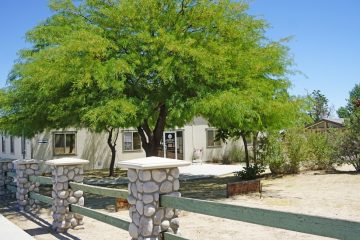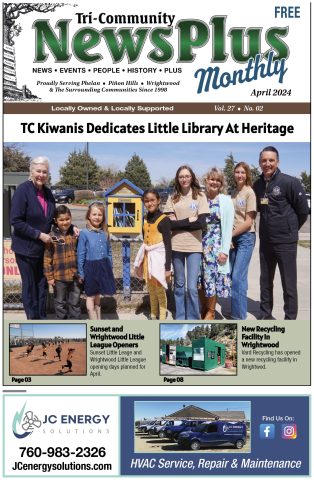The Community Teaching Garden in Phelan is a place-based learning facility that teaches nutrition from the ground up in a garden and orchard setting. They offer free garden classes, with a new garden topic each month. The July Garden topic was watering wisely and using mulch. The August topic will be feeding plants.
A Drip irrigation system is the most efficient way to water individual plants, shrubs, and trees because it slowly applies water to the soil allowing it to absorb slowly and helps avoid runoff.
Use containers to water your garden slowly, but only until the water starts to come out of the bottom of the container; otherwise, you could flush your plant of valuable nutrients. The idea is to moisten the soil to hydrate, so the nutrients are absorbable.
Try using mulch garden beds by applying 3 inches of mulch over the entire bed to help retain moisture. Vegetable plants should be watered once a day in the summer after 8 pm and before 2 am for 20 minutes.
Create a moat around young trees with mulch. Young trees need 5 gallons of water 2-4 times per week. Mature trees should be watered two times a month, and watering should be set at the canopy/ root line, not at the base of the tree. Shrubs should be watered 2- 3 days per week for 10 minutes. Mulching around the shrub will keep moisture in the soil.
Native trees should be watered once every 3 or 4 weeks for 45 minutes after being well established.
Knowing when to feed your plants is important and easy to spot. The three primary nutrients plants need during the three stages of growth are nitrogen, phosphorus, and potassium, also known as NPK.
The idea is to start with rich, healthy soil that includes well-balanced compost, aged manure, fortified bagged soil, or, for hydroponic, a balanced nutrient mixture. Even the most skilled gardeners come across nutrient differences in the soil or hydro system.
Nitrogen is considered the most important component for supporting plant growth, and lack of nitrogen shows up as the yellowing of the plant. One could add coffee grounds to the soil or fish emulsion, composted manure if working in soil beds, or actual plant nutrients/fertilizer if you are working in hydroponically or soil gardening.
During the flowering stage, phosphorus is the nutrient that aids in root development, flowering, and fruit production. Phosphorus deficiency tends to inhibit or even prevent shoot growth. Leaves turn dark, dull, even blue-green in color, and may pale in extreme deficiency. Symptoms appear on older plant parts, not new growth. Bone meal is a good source of phosphorus, and one could add more compost which also contains phosphorus. Nutrients and fertilizers can be purchased containing phosphorus and work well for soil or hydroponic gardening.
In the fruiting stage, potassium helps move water and sugar around the plant, making the fruit juices sweeter and improving the quality of flowers. Potassium deficient plants tend to wilt on dry, sunny days; the plant’s overall appearance is wilted or dropping. Wood ash added lightly as too much can burn your plants can help, or compost made primarily from food by-products such as banana peels are a good source of potassium or a store-bought nutrient/fertilizer containing potassium.
Calcium deficiency can start to show in young plants such as tomatoes. The leaves appear small and misshapen, and leaves may form brown spots that spread to the center of the leaf. Ground oyster shells or eggshells applied next to tomato, and pepper seedlings can prevent calcium deficiency which causes blossom end rot at harvest time. Most fertilizers focus on NPK, but calcium and magnesium are important as well, read the label if you purchase nutrients or fertilizer for soil or hydro.
Magnesium deficiency appears on older leaves first as they become yellow between the veins and around the leaf edges. Purple or brown may appear on the leaves. Using Epsom Salt in the garden helps plants uptake easier and improves magnesium-deficient soil, and Limestone can also bring magnesium to the garden. CAL MAG is commonly used in hydro systems.
For more information on gardening, join the group of students regularly attending each month on the second Saturday at 10 am. Happy gardening!












